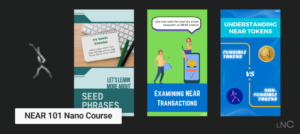In contrast with fungible tokens, non-fungible tokens (NFT) are unitary and therefore unique. This makes NFTs ideal to represent ownership of assets such as a piece of digital content, or a ticket for an event.
As with fungible tokens, NFTs are not stored in the user’s wallet, instead, each NFT lives in a NFT contract. The NFT contract works as a bookkeeper, this is: it is in charge of handling the creation, storage and transfers of NFTs.
In order for a contract to be considered a NFT-contract it has to follow the NEP-171 and NEP-177 standards. The NEP-171 & NEP-177 standards explain the minimum interface required to be implemented, as well as the expected functionality.
NFT & Marketplaces
Be mindful of not confusing an NFT with an NFT-marketplace. NFT simply store information (metadata), while NFT-marketplaces are contracts where NFT can be listed and exchanged for a price.
Community Projects
The easiest way to create and handle NFTs is by using one of the existing community projects.
- Paras – a classic NFT marketplace. Just login with your NEAR account, create a collection and share the link with your community.
- Mintbase – a marketplace that allows to create NFT collections, and buy NFTs using credit cards or stablecoins.
- Enleap – a no-code launchpad for NFTs. Provides NFT minting, staking, whitelist managing, tracking functionality.
Deploying a NFT Contract
If you want to deploy your own NFT contract, you can create one using our reference implementation
Simply personalize it and deploy it to your account.
near deploy <account-id> --wasmFile contract.wasm --initFunction newCheck the [Contract Wizard](https://dev.near.org/contractwizard.near/widget/ContractWizardUI) to create a personalized NFT contract!.
Minting a NFT
To create a new NFT (a.k.a. minting it) you will call the nft_mint method passing as arguments the metadata that defines the NFT.
See the metadata standard for the full list of TokenMetadata parameters.
Values of gas and deposit might vary depending on which NFT contract you are calling.
Minting Collections
Many times people want to create multiple 100 copies of an NFT (this is called a collection). In such cases, what you actually need to do is to mint 100 different NFTs with the same metadata (but different token-id).
Notice that [minting in Mintbase](https://raw.githubusercontent.com/Techbridge3/docs/master/docs/2.build/5.primitives/#minting-a-nft) allows you to pass a `num_to_mint` parameter.
Royalties
You might have noticed that one of the parameters is a structure called royalties. Royalties enable you to create a list of users that should get paid when the token is sell in a marketplace. For example, if anna has 5% of royalties, each time the NFT is sell, anna should get a 5% of the selling price.
Querying NFT data
You can query the NFT’s information and metadata by calling the nft_token.
Transferring a NFT
Transferring an NFT can happen in two scenarios: (1) you ask to transfer an NFT, and (2) an authorized account asks to transfer the NFT.
In both cases, it is necessary to invoke the nft_transfer method, indicating the token id, the receiver, and an (optionally) an approval_id.
Attaching NFTs to a Call
Natively, only NEAR tokens (Ⓝ) can be attached to a function calls. However, the NFT standard enables to attach a non-fungible tokens in a call by using the NFT-contract as intermediary. This means that, instead of you attaching tokens directly to the call, you ask the NFT-contract to do both a transfer and a function call in your name.
“`bash
near call
“`
Optionally, a memo parameter can be passed to provide more information to your contract.
How Does it Work?
Assume you want to attach an NFT (🎫) to a call on the receiver contract. The workflow is as follows:
- You call
nft_transfer_callin the NFT-contract passing: the receiver, a message, and the token-id of 🎫. - The NFT contract transfers the NFT 🎫 to the receiver.
- The NFT contract calls
receiver.nft_on_transfer(sender, token-owner, token-id, msg). - The NFT contract handles errors in the
nft_resolve_transfercallback. - The NFT contract returns
trueif it succeeded.
The nft_on_transfer method
From the workflow above it follows that the receiver we want to call needs to implement the nft_on_transfer method. When executed, such method will know:
- Who is sending the NFT, since it is a parameter
- Who is the current owner, since it is a parameter
- Which NFT was transferred, since it is a parameter.
- If there are any parameters encoded as a message
The nft_on_transfer must return true if the NFT has to be returned to the sender.
Approving Users
You can authorize other users to transfer an NFT you own. This is useful, for example, to enable listing your NFT in a marketplace. In such scenario, you trust that the marketplace will only transfer the NFT upon receiving a certain amount of money in exchange.
“`bash
near call
“token_id”: “
“account_id”: “
“msg”: “
}’ –accountId
“`
If the msg parameter is included, then a cross-contract call will be made to <authorized_account>.nft_on_approve(msg). Which in turn will make a callback to nft_resolve_transfer in your NFT contract.
List a NFT for sale
Basic NFT contracts following the NEP-171 and NEP-177 standards do not implement marketplace functionality.
For this purpose, there are ecosystem apps such as Paras or Mintbase, that use dedicated marketplace contracts.
In order to put a NFT for a sale on a marketplace you need to do two actions:
- Cover data storage costs in the marketplace contract.
- Approve the marketplace to sell the NFT in your NFT contract.
Buy a NFT
Basic NFT contracts following the NEP-171 and NEP-177 standards do not implement marketplace functionality.
For this purpose, there are ecosystem apps such as Paras or Mintbase, that use dedicated marketplace contracts.
Additional Resources
- NFT Tutorial (NEAR examples, JavaScript SDK) – a set of tutorials that cover how to create a NFT contract using JavaScript.
- NFT Tutorial (NEAR examples, Rust SDK) – a set of tutorials that cover how to create a NFT contract using Rust.
- NFT Tutorial by Keypom (a fork of the NEAR example tutorial).
- Paras API documentation.
- Mintbase API documentation.
- Mintbase JS SDK – a set of methods to get data from blockchain, interact with Mintbase contracts, etc.

